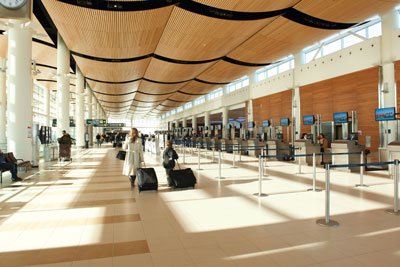
Features
Operations
Alternate Approach: Changing the airport model
Canadian National Railway (CN), NAV CANADA and major airports are among the few bright spots in an otherwise bleak national transport picture that includes rusted out and collapsing bridges, clogged highways, and creaking urban transit systems.
July 10, 2012 By David Carr
Canadian National Railway (CN), NAV CANADA and major airports are among the few bright spots in an otherwise bleak national transport picture that includes rusted out and collapsing bridges, clogged highways, and creaking urban transit systems. The three have something else in common. Each is a former federal asset that was spun off through privatization (CN), commercialization (airports) or a hybrid (NAV CANADA).
 |
|
| The Senate’s Committee on Transport and Communications is calling for an overhaul of the National Airports System. PHOTO: Winnipeg Airport Authority
|
Besides letting the federal government off the hook for losses going forward, the sale of CN and NAV CANADA poured more than $3 billion into the national treasury, while “rent” from commercialized airports continues to be the gift that keeps giving. Canada’s airport authorities paid out approximately $280 million to the federal government last year, including $133 million from Toronto’s Pearson International Airport alone. It is a practice almost unheard of in the rest of the world, according to Daniel-Robert Gooch, president of the Canadian Airports Council (CAC), a trade organization representing 46 large and small airports.
Ottawa is the poster boy of the absent landlord. It has vacuumed more than $3 billion from the system since the first airports were commercialized in 1992, while putting very little back. (Last year, Transport Canada opened the change purse with just over $20 million for upgrades at 23 smaller airports) Indeed, the more an airport authority invests to expand the enterprise the more the government skims off the top. Recently Canada’s Senate has said “enough.”
The Senate’s Committee on Transport and Communications is calling for an overhaul of the National Airports System and the creation of a National Air Travel Strategy to increase air travel in Canada and stop the bleeding of Canadians travelling to American airports to fly. The Future of Canadian Air Travel: Toll Booth or Spark Plug? argues that higher air fares, and taxes and charges that add 60 to 75 per cent to the cost of a ticket (versus 10 to 18 per cent in the U.S.), mean Canadians are often paying twice as much as Americans for a comparable flight between major cities.
“Canada is now recognized as having the best airport infrastructure in the world, according to the World Economic Forum. But we rate 125th in the same report when it comes to ticket and airport costs,” says Gooch.
The Senate wants the government to phase out airport rents and transfer ownership of airports to the local operating authorities currently leasing them for 60 years. The government is sitting on billions of dollars in airport assets; thus it’s hard to see why it would do both without getting something in return. In 2009, London’s Gatwick Airport, which is approximately the same size as Pearson in passengers handled, went for $1.9 billion during an industry downturn and with a gun to the head of the operator, BAA plc, to sell. What would Canadian airports fetch under better conditions?
Gooch says there is no interest in privatization among Canadian airports or the larger air transport industry. He is right. But that doesn’t mean an outright sale of airports is not worth a conversation especially when the financially strapped public sector is shaking trees looking for added revenue.
Privatization is not always the magic bullet it is often portrayed to be. London’s Heathrow Airport (among the first to be privatized) has taken a number of missteps after soaring following the sell-off. Likewise, Air Canada is on a different track from CN, but what legacy airline has not been battered by the popularity of the low cost phenomenon.
Also, the privatization of Canadian airports would not be as straight forward as that of Gatwick. Why, for example, should the federal government gain from the $14 billion airport authorities have invested in the system and paid for in part through airport improvement fees (also included in the rent formula)?
In policy discussions, there is a tendency in the public sector to frame the debate by “putting everything on the table” while removing hot potato issues such as privatization or toll roads, either because they are too controversial or because they rub against the ideology of the day. The Senate has opened the door to a healthy debate on the future of Canadian air transport, including airports. Transport Canada argues airport rents are not the cause of Canadians travelling south to fly, and, in isolation, they have a point. Still, airport rents are an unfair burden on Canadian air transport and need to be abolished. Handing airports over to local authorities is a trickier issue and should not be considered before examining all options, including the CN and NAV CANADA models.
David Carr is a Wings writer and columnist.